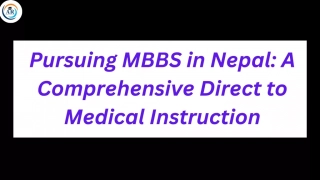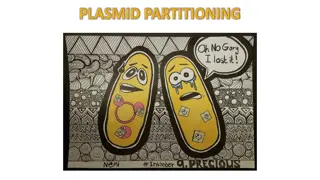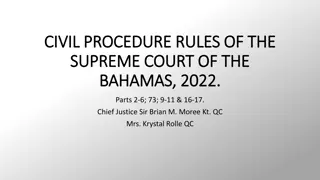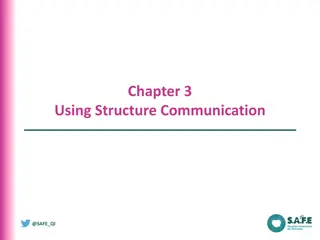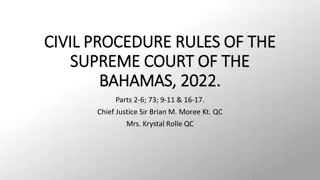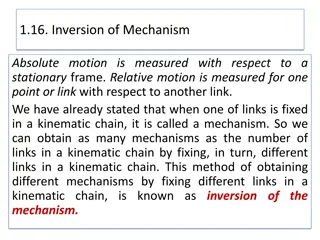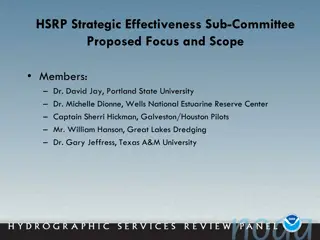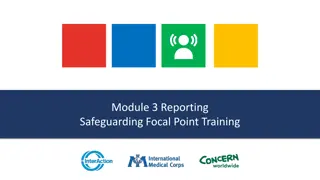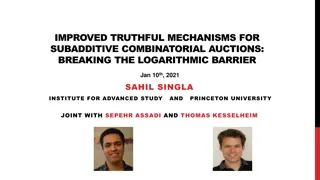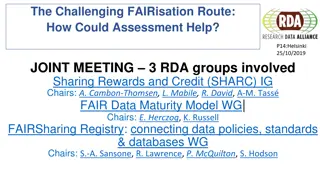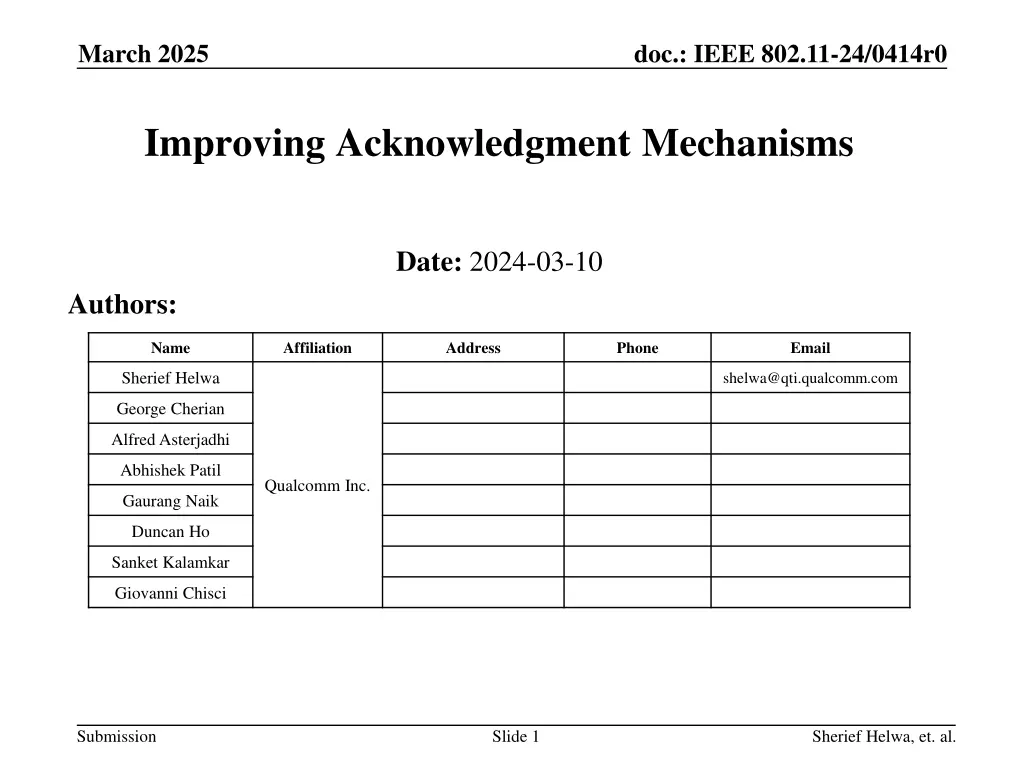
Improving Acknowledgment Mechanisms for IEEE 802.11-24/0414r0
Explore the enhancements proposed by Sherief Helwa and team for acknowledgment mechanisms in IEEE 802.11-24/0414r0 documents, focusing on Dynamic Unavailability Operation (DUO) and Multi-STA BA Frame Format to improve IDC transmission efficiency and signaling processes.
Download Presentation

Please find below an Image/Link to download the presentation.
The content on the website is provided AS IS for your information and personal use only. It may not be sold, licensed, or shared on other websites without obtaining consent from the author. If you encounter any issues during the download, it is possible that the publisher has removed the file from their server.
You are allowed to download the files provided on this website for personal or commercial use, subject to the condition that they are used lawfully. All files are the property of their respective owners.
The content on the website is provided AS IS for your information and personal use only. It may not be sold, licensed, or shared on other websites without obtaining consent from the author.
E N D
Presentation Transcript
March 2025 doc.: IEEE 802.11-24/0414r0 Improving Acknowledgment Mechanisms Date: 2024-03-10 Authors: Name Affiliation Address Phone Email Sherief Helwa shelwa@qti.qualcomm.com George Cherian Alfred Asterjadhi Abhishek Patil Qualcomm Inc. Gaurang Naik Duncan Ho Sanket Kalamkar Giovanni Chisci Submission Slide 1 Sherief Helwa, et. al.
September 2024 doc.: IEEE 802.11-24/0414r0 Introduction The In-Device Coexistence (IDC) topic has been of great interest to the TGbn group for a long time. In the past meetings, multiple motions related to IDC have passed which cover different aspects of IDC operation and signaling, e.g., Motions 30, 136, 137, 138, 139, etc. Additionally, the PDT for IDC PDT MAC Coexistence was successfully motioned in January (https://mentor.ieee.org/802.11/dcn/24/11-24-2040-09- 00bn-pdt-mac-coexistence.docx). This is reflected in subclause 37.11 of the D0.1 spec document including multiple sections covering: Dynamic Unavailability Operation (DUO) Periodic Unavailability Operation (PUO) (for AP and non-AP STAs) Non-AP STA Parameter Update This motion allows for two unavailability (due to IDC) reporting schemes : In this contribution we focus on the DUO mode and propose some signaling- related ideas for this mode of operation. Submission Slide 2 Sherief Helwa, Qualcomm Inc.
September 2024 doc.: IEEE 802.11-24/0414r0 Dynamic Unavailability Operation (DUO) Before a DUO STA becomes unavailable due to IDC transmission, its peer STA needs to be made aware of its unavailability. Two mechanisms can be used to achieve that goal: Solicited unavailability reporting Solicit Report unavailability info Unavailability period unavailability info Peer STA PPDU ICF STA with IDC ICR CRF Original intended PPDU end time Report unavailability info and send BA bitmap Available Unavailable Unsolicited unavailability reporting Report Unavailability period unavailability info Peer STA BA ICR STA with IDC ICF UL PPDU Send unavailability info in ICF Available Unavailable Submission Slide 3 Sherief Helwa, Qualcomm Inc.
September 2024 doc.: IEEE 802.11-24/0414r0 Multi-STA BA Frame Format Multi-STA BA was agreed to be used as a carrier for control feedback information where the control info is included instead of the BlockAck Bitmap in Per AID TID Info field. Since there are different types of possible feedback info to report. Therefore, there is a need to include a Feedback Type field in the Per AID TID Info field to indicate the type of control info included in this field. We propose to set the length of the Feedback Type field to 4 bits and include it in the last 4 bits of the Block Ack Starting Sequence Control field, i.e., B12 to B15. The rest of the Starting Sequence Number field will be reserved. For example, the Feedback Type field will be set to 0 to indicate DUO unavailability info. Per AID TID Info Block Ack Starting Sequence Control Block Ack Bitmap AID TID Info Octets: 2 2 4 Fragment Number Feedback Type Unavailability Target Start Time Unavailability Duration Reserved Reserved 9 Bits: 9 14 Bits: 4 8 4 Starting Sequence Number Set to 0 to indicate DUO unavailability info Submission Slide 4 Sherief Helwa, Qualcomm Inc.
September 2024 doc.: IEEE 802.11-24/0414r0 Unavailability Info Format It is agreed to report the DUO unavailability information in terms of two parameters/fields (Motion 142): Unavailability Target Start Time (9 bits) Unavailability Duration (9 bits) We propose the following encoding for these two fields: Unavailability Target Start Time (9 bits): This subfield contains a positive unsigned integer corresponding to a partial TSF time at which the unavailability event is expected to start Except that this subfield is reserved (i.e., invalid and to be ignored by the recipient) if the Unavailability Duration subfield is equal to 0 Unavailability Duration (9 bits) This subfield is set to the estimated duration, in units of 64 microseconds, of the unavailability event except that The value 0 indicates that the STA is available The value 511 indicates that the STA is unavailable for an indefinite duration of time The STA shall use the value 511 only if the unavailability duration is unknown After a DUO STA reports an indefinite duration of unavailability, it can later update its state by sending an unavailability report with Unavailability Duration set to 0 to indicate availability or another value that is not equal to 511 to report updated unavailability. Slide 5 Submission Sherief Helwa, Qualcomm Inc.
September 2024 doc.: IEEE 802.11-24/0414r0 Internal Interference Indication In some scenarios, A DUO STA s unavailability period may overlap with some data PPDUs causing errors. In that case, it will be useful if the DUO STA indicated to the AP that those errors were due to internal interference. We propose to have a 1-bit indication sent back by the DUO STA carrying this information. Unavailability period AP DL PPDU DUO STA M-BA Indicate that errors occurred due to internal reasons Available Unavailable Submission Slide 6 Sherief Helwa, Qualcomm Inc.
September 2024 doc.: IEEE 802.11-24/0414r0 Summary Details for DUO-relating signaling was discussed including: How to indicate the control feedback information type included in a Multi- STA BA frame and how to use that for the DUO mode. The encoding of unavailability information reported by a DUO STA. Internal interference indication made by the DUO STAs in cases of error. Submission Slide 7 Sherief Helwa, Qualcomm Inc.
September 2024 doc.: IEEE 802.11-24/0414r0 Straw Poll 1 Do you support the following amendment to the consensus: o Unavailability Target Start Time is indicated using 9 bits with a granularity of 64us This subfield contains a positive unsigned integer corresponding to a partial TSF time at which the unavailability event is expected to start Except that this subfield is reserved (i.e., invalid and to be ignored by the recipient) if the Unavailability Duration subfield is equal to 0 o Unavailability Duration is indicated using 9 bits with a granularity of 64us This subfield is set to the estimated duration, in units of 64 microseconds, of the unavailability event except that The value 0 indicates that the STA is available The value 511 indicates that the STA is unavailable for an indefinite duration of time The STA shall use the value 511 only if the unavailability duration is unknown o A non-AP STA that intends to transition to available state shall indicate to its associated AP that it transitions from being unavailable to being available by sending a BSRP GI3 Trigger frame with the Unavailability Duration field set to 0. Submission Slide 8 Sherief Helwa, Qualcomm Inc.
September 2024 doc.: IEEE 802.11-24/0414r0 Straw Poll 2 Do you support to amend the consensus as follows: Do you support to define a special Feedback Per AID TID Info field (name TBD) that carries control feedback in the M-BA frame? o The control feedback (i.e. unavailability indication) is carried instead of the BlockAck Bitmap in that Feedback Per AID TID Info field o The Ack Type subfield of the Per AID TID Info field is set to 0 and the TID subfield of the Per AID TID Info field is set to 13 o The AID11 subfield of this Per AID TID Info field is set to 2008 value if the control feedback is addressed to all STAs or to the AID11 that identifies the intended recipient STA o The Starting Sequence Number field of this Per AID TID Info field is reserved o A Feedback Type field (4-bit field B12 to B15 of the Block Ack Starting Sequence Control field) which is set to 0 to indicate that this Per AID TID Info field is carrying CoEx unavailability information. The rest of the Starting Sequence Number bits are reserved. Submission Slide 9 Sherief Helwa, Qualcomm Inc.
September 2024 doc.: IEEE 802.11-24/0414r0 Straw Poll 3 Do you support to add internal errors reporting in M-BA frame o Internal (in device) Error Occurred bit is 1 if internal (in-device) error(s) occurred during the reception of the PPDU that solicited the M-BA response I.e., unsuccessful RX reports in BlockAck Bitmaps in the M-BA are due to internal errors o Internal (in device) Error Occurred bit is 0 if no internal (in-device) error(s) occurred or if the source of error is unknown I.e., unsuccessful RX reports (if any) in BlockAck Bitmaps in M-BA are not due to internal (in-device) errors or if the source of error is unknown o Location of the Internal Error Occurred bit in the M-BA frame is TBD o Note: Internal errors might be due to internal in-device coexistence or other internal limitations Submission Slide 10 Sherief Helwa, Qualcomm Inc.

